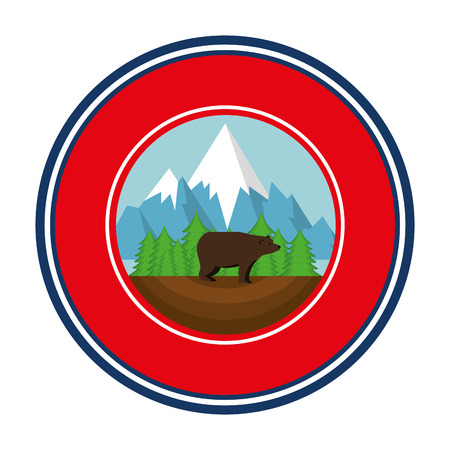1. Best Scenic Camping Spots Along the Appalachian Trail
If youre dreaming of waking up to panoramic mountain views, serene forests, and unforgettable sunrises, these scenic campgrounds along the Appalachian Trail are just what you need. Perfect for nature lovers, hikers, and outdoor photographers, each spot offers a unique blend of natural beauty and peaceful vibes.
Top Campgrounds with Stunning Mountain Views
The Appalachian Trail stretches over 2,190 miles from Georgia to Maine, crossing through some of the most beautiful mountainous regions in the eastern U.S. Heres a list of top-rated campgrounds where you can enjoy incredible landscapes:
| Campground | State | Mountain Range | Best Features |
|---|---|---|---|
| Max Patch | North Carolina | Great Smoky Mountains | 360° mountain views, open grassy summit |
| Roan High Knob Shelter | Tennessee | Roan Highlands | Highest shelter on the AT, spruce-fir forest setting |
| Grayson Highlands State Park | Virginia | Blue Ridge Mountains | Wild ponies, sweeping vistas, boulder fields |
| Saddleback Mountain Campsites | Maine | Saddleback Range | Lakeside views and rugged alpine terrain |
| Clingmans Dome Area | Tennessee/North Carolina Border | Great Smoky Mountains | AT’s highest point, misty mountain scenery |
Why These Campgrounds Are Worth Visiting
Each of these spots not only offers jaw-dropping views but also provides a peaceful place to recharge after a long hike. Whether youre capturing sunrise photos from Max Patch or enjoying a quiet night under the stars at Roan High Knob, these sites bring you closer to nature in the most memorable way.
Tips for Scenic Camping on the Appalachian Trail
- Plan ahead: Popular scenic spots can fill up quickly during peak seasons.
- Pack light but smart: Bring your camera gear if photography is your goal—but make sure it’s trail-friendly.
- Follow Leave No Trace principles: Help preserve these beautiful places for future adventurers.
- Check weather conditions: Mountain weather can change fast—be prepared for sudden shifts.
No matter where you stop along the Appalachian Trail, these scenic campgrounds offer views that will stay with you forever. Keep your camera ready and your eyes open—you never know when youll catch that perfect mountain moment.
2. Family-Friendly Campgrounds with Easy Trail Access
When planning a family camping trip along the Appalachian Trail, safety and accessibility are top priorities. Thankfully, there are several mountain campgrounds that offer both comfort and convenience for families traveling with children. These campgrounds feature nearby trailheads, beginner-friendly hikes, and amenities that make outdoor adventures easy and enjoyable for all ages.
What Makes a Campground Family-Friendly?
Family-friendly campgrounds usually have the following features:
- Easy access to hiking trails suitable for beginners
- Clean restrooms and potable water
- Designated picnic areas and fire pits
- Ranger-led programs or visitor centers with educational exhibits
- Safe environments away from steep cliffs or hazardous terrain
Top Picks for Families Along the Appalachian Trail
Here are some of the best mountain campgrounds on the Appalachian Trail that cater to families:
| Campground | State | Trail Access | Family Features |
|---|---|---|---|
| Shenandoah National Park – Big Meadows Campground | Virginia | Near multiple short loop hikes on the AT | Visitor center, ranger programs, flush toilets |
| Great Smoky Mountains National Park – Elkmont Campground | Tennessee | Close to Little River Trail & Laurel Falls Trail | Spacious sites, seasonal events, easy trailheads nearby |
| Mount Greylock State Reservation – Sperry Campground | Massachusetts | Access to family-friendly trails like Stony Ledge Loop | No vehicle traffic (walk-in only), picnic shelters, scenic views |
| Bear Mountain State Park – Beaver Pond Campground | New York | Paved paths to AT sections and lake trails | Lakeside beach, playgrounds, easy walking trails |
| Cowans Gap State Park Campground | Pennsylvania | Nearby Tuscarora Trail connects with AT segments | Swimming lake, paddle boats, flat hiking loops |
Why These Campgrounds Stand Out for Families
Each of these campgrounds offers more than just a place to pitch a tent—they provide a gateway to outdoor fun that’s safe and manageable for kids. Whether it’s splashing in a lake after a morning hike or learning about wildlife at a park ranger talk, these spots help spark a lifelong love for nature. Plus, their proximity to well-maintained sections of the Appalachian Trail means you can enjoy the beauty of the mountains without tackling difficult climbs.
Planning Tips for Your Family Adventure
- Book early: Popular family-friendly sites fill up quickly during peak season.
- Pack layers: Mountain weather can shift fast—even in summer.
- Create simple goals: Choose one or two short hikes per day and build in plenty of downtime.
- Bring trail snacks: Keep energy up with granola bars, fruit, and lots of water.
- Involve the kids: Let them help pick trails or gather kindling—it builds excitement and responsibility.
The Appalachian Trail has plenty of welcoming places where families can relax and explore together. With so many accessible campgrounds surrounded by gentle trails and natural beauty, your next mountain adventure can be as fun as it is unforgettable.

3. Remote Backcountry Campsites for True Wilderness Experiences
If youre an experienced hiker looking to escape the crowds and get off the beaten path, the Appalachian Trail offers some incredible backcountry campsites tucked deep within the mountains. These remote sites arent just places to sleep — theyre gateways to solitude, raw nature, and unforgettable mountain views. Perfect for those who want a deeper connection with the trails wild heart.
What Makes Backcountry Camping Special?
Unlike front-country campgrounds that often come with drive-up access and basic amenities, backcountry campsites require a hike — sometimes several miles in — to reach. What you trade in convenience, you gain in peacefulness, starry skies, and a true sense of adventure. Be prepared: these sites often have no facilities, so youll need to practice Leave No Trace principles and pack everything in and out.
Top Remote Backcountry Campsites Along the Appalachian Trail
Here are some standout mountain backcountry sites along the AT that seasoned hikers love:
| Campsite | State | Trail Access Point | Highlights |
|---|---|---|---|
| Spence Field | Tennessee/North Carolina | Clingmans Dome or Fontana Dam | Sweeping Smoky Mountain vistas, frequent wildlife sightings |
| Overmountain Shelter Area | North Carolina | Carvers Gap | Located in a red barn, panoramic views of Roan Highlands |
| Ethan Pond Campsite | New Hampshire | Crawford Notch | Lakeside camping in the White Mountains; moose spotting opportunities |
| Spearhead Trail Campsites (Grayson Highlands) | Virginia | Massey Gap | Open meadows with wild ponies and stunning highland views |
| The Priest Shelter Area | Virginia | Tye River Trailhead | Secluded ridge-top site with challenging elevation gain rewards |
Things to Know Before You Go:
- No Reservations: Most backcountry sites are first-come, first-served.
- Bears Are Common: Bring a bear canister or hang your food properly.
- Packing Light is Key: Youll be carrying everything on your back — choose gear wisely.
- Navigation Skills Help: Some sites are less marked than others — having a map or GPS is smart.
A True Escape Into Nature
If you crave silence under the stars and waking up to nothing but birdsong and mountain air, these remote campsites offer that rare kind of peace only found deep in the wilderness. They’re perfect for hikers who don’t mind putting in the miles to find something truly special.
4. Campgrounds with Amenities for Comfortable Stays
If you love the great outdoors but still want a few home comforts, there are several campgrounds along the Appalachian Trail that offer just the right balance. These spots let you enjoy mountain views and fresh air without giving up essentials like clean restrooms, drinkable water, and picnic areas.
Why Choose Campgrounds with Amenities?
When youre hiking or camping for several days, having access to basic facilities can make a big difference. A good nights sleep, easy access to water, and a place to cook your meals can turn a tough trip into an enjoyable one. These campgrounds are perfect for families, beginners, or anyone who wants a more relaxed outdoor experience.
Top Appalachian Trail Campgrounds with Amenities
| Campground Name | Location | Amenities |
|---|---|---|
| Grayson Highlands State Park | Virginia | Restrooms, hot showers, potable water, fire rings, picnic tables |
| Bald Mountain Campground | Tennessee | Pit toilets, drinking water access, fire pits |
| Catawba Mountain Shelter Area | Virginia | Shelter structure, nearby spring water, picnic area |
| Mount Greylock Campsites | Massachusetts | Restrooms, potable water, picnic tables |
| Lafayette Place Campground | New Hampshire (White Mountains) | Flush toilets, showers, water spigots, ranger station |
Amenities That Matter Most
The most appreciated amenities often include:
- Clean Restrooms: Whether its flush toilets or well-maintained pit toilets, its always a plus.
- Potable Water: Having safe drinking water on-site saves time and effort.
- Fire Rings: Great for cooking and staying warm during chilly mountain nights.
- Picnic Areas: Perfect for relaxing meals with scenic views.
Tips for a Comfortable Stay
- Reserve Early: Popular campgrounds fill up fast during peak hiking seasons.
- Packed Light but Smart: Bring gear that adds comfort without weighing down your pack—like a cozy sleeping pad or compact camp chair.
- Respect the Space: Leave no trace by cleaning up after yourself and respecting quiet hours.
Amenities can make your Appalachian Trail experience smoother and more enjoyable. Whether youre planning a weekend getaway or a longer hike through the mountains, these campgrounds offer that extra level of ease without taking away from the beauty of the trail.
5. Best Seasons and Tips for Camping the Appalachian Trail
The Appalachian Trail stretches over 2,190 miles across 14 states, offering a wide range of climates and terrains. Knowing the best time to visit and how to prepare can make or break your mountain camping experience. Heres what you need to know before heading out to one of the top 10 mountain campgrounds along the trail.
Best Seasons to Camp on the Appalachian Trail
The ideal time for camping depends on which section of the trail youre exploring. Generally, late spring through early fall offers the most comfortable weather. However, each region has its own sweet spot:
| Region | Best Months | Weather Notes |
|---|---|---|
| Southern Appalachians (Georgia to North Carolina) | March – May, September – November | Mild temps; spring wildflowers and fall foliage are beautiful |
| Mid-Atlantic (Virginia to Pennsylvania) | April – June, September – October | Avoid summer heat and humidity; great views in autumn |
| Northern Appalachians (New York to Maine) | June – August | Cooler summers; watch out for black flies in early summer |
Packing Tips for Mountain Campgrounds
Campsites in the mountains come with unique challenges. Whether youre staying at Roan Highlands or Mount Greylock, heres what you should pack:
- Layered clothing: Weather can change fast at higher elevations.
- Rain gear: Afternoon showers are common in mountainous areas.
- Bear-proof food containers: Essential in bear-active zones like Shenandoah National Park.
- Trekking poles: Helpful for steep ascents and rocky terrain.
- Sufficient water treatment supplies: Not all campsites have potable water sources.
Permits and Regulations
You won’t need a permit for most parts of the Appalachian Trail, but some campgrounds—especially within national parks—do require them. Here are a few examples:
| Campsite Area | Permit Required? | Where to Get It |
|---|---|---|
| The Smokies (Great Smoky Mountains NP) | Yes | NPS website or Backcountry Permit Office |
| Baxter State Park (Maine) | Yes | Baxter State Park Authority website |
| SNP – Shenandoah National Park | No (but backcountry registration recommended) | NPS visitor center or online form |
Leave No Trace Essentials
The Appalachian Trail is a shared natural treasure, so its important to follow Leave No Trace principles when staying at any campground:
- Plan ahead and prepare: Know your route, weather forecast, and campground rules.
- Travel and camp on durable surfaces: Use designated campsites and trails.
- Dispose of waste properly: Pack out all trash, leftover food, and toilet paper.
- Leave what you find: Don’t pick plants or disturb historical structures.
- Minimize campfire impact: Use a stove or established fire rings only.
- Respect wildlife: Store food securely and keep a safe distance.
- Be considerate of other visitors: Keep noise down and yield to hikers going uphill.
Your Adventure Awaits!
If youre planning to explore the top 10 mountain campgrounds along the Appalachian Trail—from Max Patch’s open meadows to Katahdins rugged peaks—timing your trip right and preparing smart will ensure an unforgettable outdoor experience.


